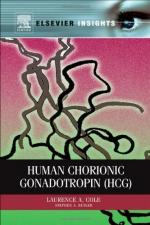|
This section contains 378 words (approx. 2 pages at 300 words per page) |
Human chorionic gonadotropin (HCG) is a glycoprotein hormone produced by the extraembryonic tissue of the early human embryo. After fertilization, the human zygote undergoes cleavage followed by the formation of a blastocyst. The blastocyst is a hollow sphere constructed of an inner cell mass, which becomes the embryo proper, and a trophoblast, which is embryonic tissue that will contribute to the formation of the placenta. The portion of the trophoblast that is invasive into the maternal uterus is known as the syncytiotrophoblast. The syncytiotrophoblast is the tissue of origin of HCG. The hormone is produced early in pregnancy and increases in rate of production until about the tenth week of pregnancy. Thereafter it decreases. The function of HCG is to stimulate the production of progesterone by the corpus luteum. This assures a continual supply of ovarian progesterone until the placenta develops a supply of progesterone around seven weeks of gestation. Progesterone prepares the uterine lining, the endometrium, for implantation and maintainence of the embryo.
The presence of HCG in the urine of a woman is indicative of pregnancy. Actually, the test reveals the presence of trophoblast cells and does not in any way indicate the health of the fetus. Early on, there were mice (Aschheim- Zondek) and rabbit (Friedman) tests for the presence of HCG in urine. However, these were expensive. Later, the leopard frog, Rana pipiens, was shown to be much less expensive as a biological test organism. A male leopard frog will release living sperm in an hour after receiving an injection of morning urine containing HCG. Somewhat similarly, female African clawed toads, Xenopus laevis, will release eggs after receiving an injection of HCG-containing urine. These tests have now been replaced with even more sensitive clinical tests, one of which will reveal pregnancy prior to the first missed period.
Cryptorchidism is a condition where the testes do not descent into the scrotum of a newborn baby. This is a serious condition because abdominal testes are vulnerable to testicular cancer at a much higher incidence than normal testes. Further, abdominal testes are generally sterile. Some infants respond to HCG treatment of this condition. HCG enhances maturation of the external genitals and often causes the undescended testes to move into the scrotum.
|
This section contains 378 words (approx. 2 pages at 300 words per page) |


